 |
 |
 |
| |
An Open Label, Comparative, Multicenter Study Of Peginterferon Alfa-2a Plus Ribavirin In The Treatment Of Patients With Chronic
Hepatitis C/Hepatitis B Dual Infection Versus Those With Chronic Hepatitis C Mono-infection
|
| |
| |
Reported by Jules Levin
AASLD, Nov 2-6, 2007, Boston, MA
C-J Liu,1 W-L Chuang,2 C-M Lee,3 S-S Wu,4 L-Y Liao,5 H-T Kuo,6 Y-C Chao,7 C-L Chen,1 P-J Chen,1 D-S Chen1
1National Taiwan University College of Medicine and National Taiwan University Hospital, Taiwan. 2Kaohsiung Medical University Hospital, Taiwan. 3Chang Gung Memorial Hospital, Kaohsiung, Taiwan. 4Changhua Christian Hospital, Taiwan. 5Ren-Ai Branch, Taipei City Hospital, Taiwan. 6Chi-Mei Medical Center, Taiwan. 7Tri-Service General Hospital, Taiwan.
Presented at the 58th Annual Meeting of the American Association for the Study of Liver Diseases, November 2007, Boston, USA
Background
Dual infection with hepatitis B virus (HBV) and hepatitis C virus (HCV) is not uncommon (especially in areas with a high endemic level of both infections) with a prevalence of around 7-11% in patients with chronic HBV infection and 2-10% of chronic hepatitis C patients1-3
Patients with dual HBV and HCV infection have more severe liver disease and an increased risk of hepatocellular carcinoma (HCC)4,5
Few data exist on treatment of dual infection. Trials assessing the treatment of dually infected patients with conventional interferon (IFN) monotherapy have been disappointing6,7
Recent pilot studies using conventional IFN in combination with ribavirin for the treatment of patients with dual chronic hepatitis C and B for 6 months, have shown a sustained HCV clearance rate comparable to that in HCV mono-infected patients8-10
To date no clinical trial has assessed the use of peginterferon-based combination therapy in dual HBV and HCV infection
Summary
A sustained HCV clearance rate of 73% was achieved at 24 weeks post-treatment in the most difficult-to-treat patients dually infected with HCV genotype 1 and HBV
In HCV genotype non-1 dually infected patients, HCV clearance (86%) was achieved to an extent comparable to that observed in HCV mono-infected patients (77% and 88% for genotype 1 and non-1 infected patients, respectively)
In general there was little difference between HCV response rates between genotype 1 and non-1 infected patients at end of treatment and 24 weeks post-treatment
HBV virologic response was obtained in 56% of the patients with dual HCV/HBV infection
Importantly, HBsAg clearance was observed in 10% of the dually infected patients
36% of the dually infected patients whose serum HBV DNA were undetectable pre-treatment experienced rebound of HBV DNA
CONCLUSION
Combination therapy of PEGASYS and COPEGUS appears to be safe and effective for treatment of patients dually infected with HCV and HBV. Importantly, a substantial proportion of the dually infected patients achieved HBsAg clearance - an important indicator of long-term treatment success
OBJECTIVE
To evaluate the efficacy and safety of peginterferon alfa-2a (40KD) (PEGASYS) in combination with ribavirin for the treatment of patients with chronic HCV/HBV dual infection compared with those mono-infected with chronic hepatitis C
METHODS
Eligible patients with active HCV (serum ALT level >1.5 x upper limit of normal and HCV RNA level >1,000 copies/mL), with (n=161) or without (n=160) detectable HBsAg, were consecutively enrolled (Figure 1)
Patients infected with HCV genotype 1 received a 48-week combination therapy with PEGASYS 180 _g weekly plus daily COPEGUS 1000-1200 mg (n=207)
Patients with HCV genotype non-1 received a 24-week combination therapy with PEGASYS 180 _g weekly plus daily COPEGUS 800 mg (n=114)
The primary efficacy parameter was sustained virological (HCV RNA) response (SVR) at 24 weeks posttreatment.
HCV RNA was measured using a commercial real-time PCR assay with a lower limit of detection of 25 IU/mL (Cobas® Taqman® HCV Test v2.0)
Primary analysis was intention-to-treat (ITT) with a per protocol (PP) secondary analysis
Secondary efficacy parameters included ALT normalization, HBV virologic response (VR) (<1,000 copies/mL) and HBsAg clearance at end of treatment and 24 weeks post-treatment
HBV DNA was also measured using an in-house real-time PCR assay with a lower limit of detection of 1,000 copies/mL
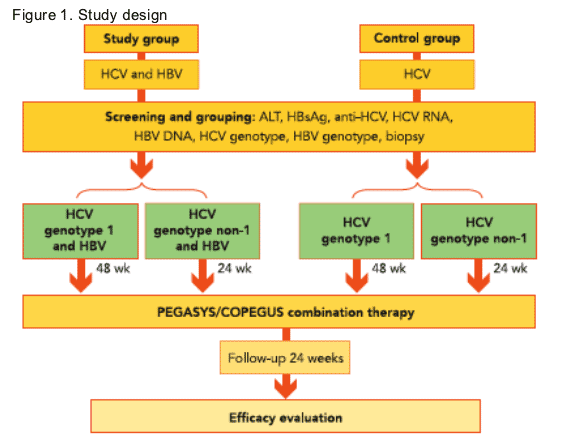
RESULTS
Patient recruitment and enrolment
Patients were recruited from June 2004. Treatment and follow-up was completed in August 2007.
Here we present final results obtained in September 2007
The majority of dually infected patients were male (Table1)
The group containing HCV genotype non-1 mono-infected patients had a higher proportion of female patients enrolled than the other patient groups
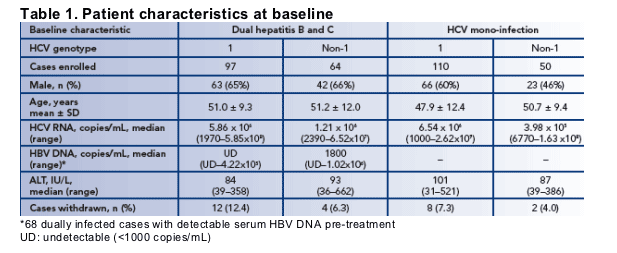
Intention-to-treat (ITT) analysis
The ITT analysis included all patients that received at least one dose of study treatment; withdrawn cases with missing data at 24 weeks post-treatment were counted as treatment failure
A total of 26 (8.1%) patients were withdrawn prematurely from the study (Table 1)
HCV response
HCV genotype non-1 infected patients had a slightly better sustained response than genotype 1 patients in both HCV and HBV dually infected and HCV mono-infected patients (Figure 2)
HCV clearance rates were comparable at the end of treatment (88% vs 94%) and 24 weeks posttreatment (86% vs 88%) for dually infected and HCV mono-infected patients with non-1 genotype infection, respectively
The majority of HCV genotype 1 infected patients with dual HCV/HBV infection achieved a sustained response (73%) after 24 weeks of treatment-free follow up and an even higher rate of HCV clearance was achieved in HCV mono-infected patients (77%)
A per protocol analysis, including data for all patients completing 12 weeks of treatment, shows comparable end-of-treatment and sustained responses (Figure 3)
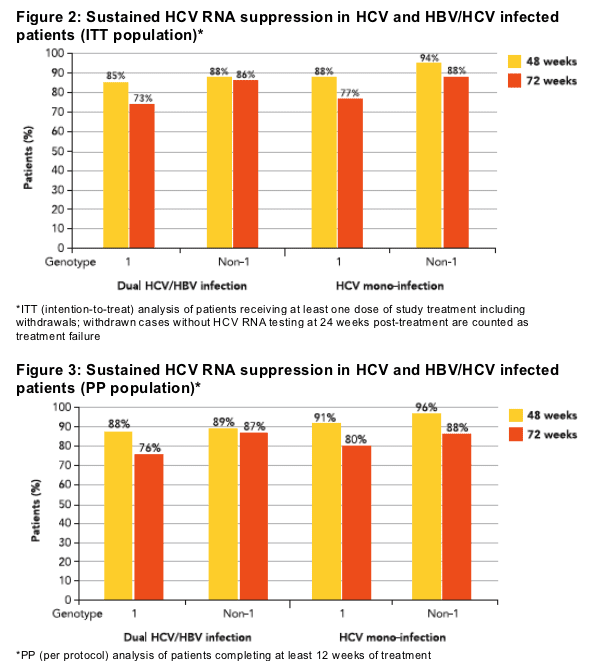
HBV response
Virological
Of the 145 dually infected patients with available data for analysis, 68 (46.9%) had detectable serum HBV DNA pre-treatment
Of the 68 patients with baseline detectable serum HBV DNA, HBV virologic response (VR) was obtained in 47 (69.1%) at the end of treatment and in 38 (55.9%) at the end of follow-up (Table 2)
Of the 77 patients with baseline undetectable serum HBV DNA, rebound of HBV DNA was found in 28 (36.4%), including 16 (20.8%) and 17 (22.1%) at the end of treatment and follow-up, respectively (Table 2)
None of the HBV rebounds was associated with an elevation of serum ALT >200 IU/L, and almost all showed an HCV SVR (Table 3)
HBsAg clearance
10% of the dually infected patients cleared HBsAg at the end of treatment-free follow-up
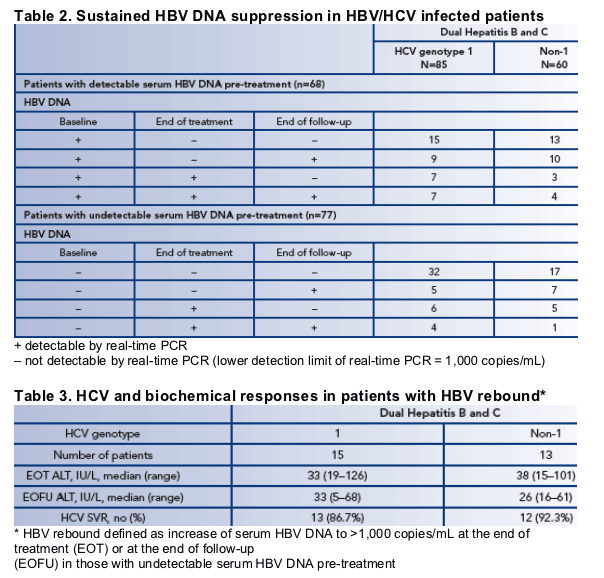
The HBV virological profile of dually infected patients with HCV genotype 1 and HCV genotype non-1 before and after combination treatment are shown in Tables 4 and 5, respectively
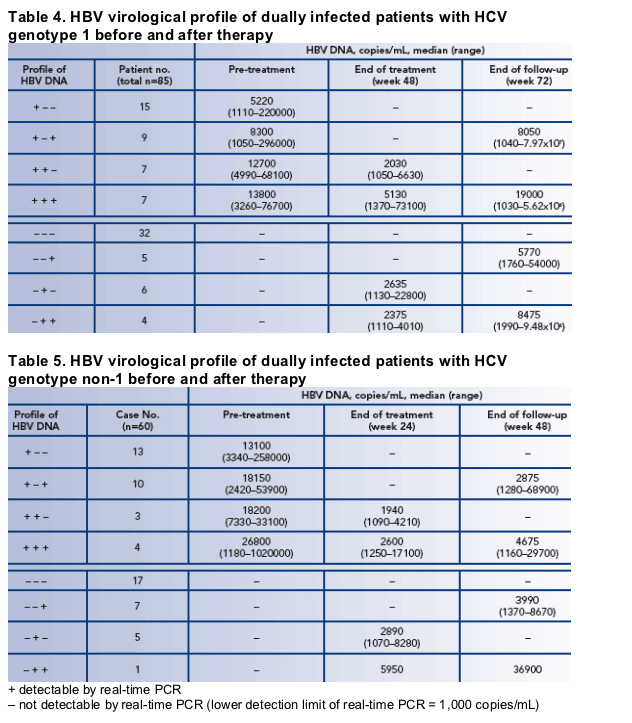
Biochemical response
HCV mono-infected patients had a slightly higher ALT normalization rate than HCV/HBV dually infected patients at the end of treatment and post-treatment follow-up (ITT analysis) (Figure 4)
The majority of HCV genotype 1 infected patients with dual HCV/HBV infection achieved a biochemical response (62%) after 24 weeks of treatment-free follow up and an even higher rate of HCV clearance was achieved in HCV mono-infected patients (70%)
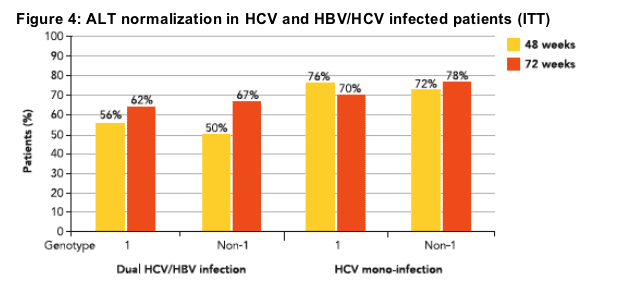
Safety
Patient withdrawals
Causes of the 26 withdrawals from the study are shown in Table 6
The two most common reasons for withdrawal (2.5% of patient population) were non-compliance and skin lesions
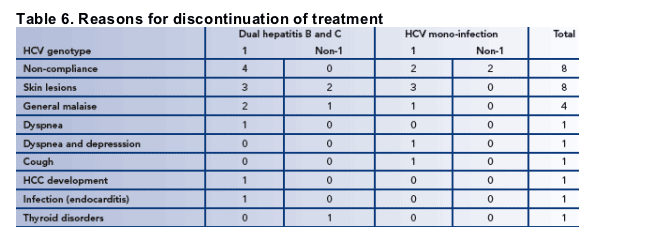
REFERENCES
1. Liu Z, Hou J. Hepatitis B virus (HBV) and hepatitis C virus (HCV) dual infection. Int J Med Sci 2006;3(2):57-62
2. Chen DS, Kuo GC, Sung JL, et al. Hepatitis C virus infection in an area hyperendemic for hepatitis B and chronic liver disease: the Taiwan experience. J Infect Dis 1990;162:817-22
3. Liu CJ, Liou JM, Chen DS, Chen PJ. Natural course and treatment of dual hepatitis B virus and hepatitis C virus infections. J Formos Med Assoc 2005;104(11):783-91
4. Sagnelli E, Coppola N, Scolastico C, et al. Virologic and clinical expressions of reciprocal inhibitory effect of hepatitis B, C, and delta viruses in patients with chronic hepatitis. Hepatology 2000;32(5):1106-10
5. Benvegnu L, Fattovich G, Noventa F, et al. Concurrent hepatitis B and C virus infection and risk of hepatocellular carcinoma in cirrhosis. A prospective study. Cancer 1994;74(9):2442-8
6. Sagnelli E, Coppola N, Scolastico C, et al. Isolated anti-HBc in chronic hepatitis C predicts a poor response to interferon treatment. J Med Virol 2001;65(4):681-7
7. Khattab E, Chemin I, Vuillermoz I, et al. Analysis of HCV co-infection with occult hepatitis B virus in patients undergoing IFN therapy. J Clin Virol 2005;33(2):150-7
8. Chuang WL, Dai CY, Chang WY, et al. Viral interaction and responses in chronic hepatitis C and B coinfected patients with interferon-alpha plus ribavirin combination therapy. Antivir Ther 2005;10(1):125-33
9. Liu CJ, Chen PJ, Lai MY, et al. Ribavirin and interferon is effective for hepatitis C virus clearance in hepatitis B and C dually infected patients. Hepatology 2003;37:568-76
10. Hung CH, Lee CM, Lu SN, et al. Combination therapy with interferon-alpha and ribavirin in patients with dual hepatitis B and hepatitis C virus infection. J Gastroenterol Hepatol 2005;20(5):727-32
DISCLOSURE INFORMATION
This research was investigator-initiated (P-J Chen and D-S Chen) and partly funded by F. Hoffmann-La Roche Ltd, Basel, Switzerland.
We would like to acknowledge the assistance of Elements Communications in the preparation of the poster.
|
| |
|
 |
 |
|
|